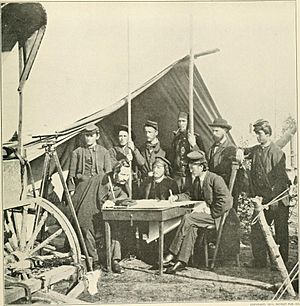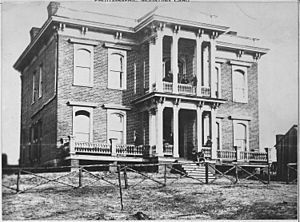United States Army Corps of Topographical Engineers facts for kids
Quick facts for kids U.S. Army Corps of Topographical Engineers |
|
|---|---|
| Active | 1838–1863 |
| Country | . |
| Allegiance | |
| Branch | Regular Army |
| Commanders | |
| Notable commanders |
John James Abert (1838–61) Stephen Harriman Long (1861–63) |
The U.S. Army Corps of Topographical Engineers was a special group within the United States Army. It was officially started on July 4, 1838. This group was made up only of officers. These officers were chosen from the best students at West Point.
Their main jobs were to map new lands and design important public projects. These projects included building lighthouses, forts along the coast, and new routes for ships. Famous members included George Meade and John C. Frémont. The Corps joined with the United States Army Corps of Engineers on March 31, 1863. After this, the Corps of Engineers also took over the Lakes Survey for the Great Lakes.
In 1841, a special group called the Lake Survey was created. It was based in Detroit, Michigan. Its job was to map the Great Lakes and create navigation charts. These charts helped ships find their way. The Lake Survey published its first maps in 1852.
Contents
Why Were the Topographical Engineers Important?
The Corps of Topographical Engineers was a small but very important part of the Army. They worked from 1838 until the Civil War. These engineers were experts at mapping and recording everything they found. This included main roads and wild, unexplored areas.
As Army officers, they helped the U.S. government expand across the continent. This idea was called Manifest Destiny. Before the Civil War, their explorations led to the first scientific maps of the American West. They helped mark national borders. They also helped people settle new lands by finding and building wagon roads. They improved rivers and harbors for travel. They even looked for underground water in dry areas.
In short, they acted like a public works department for the entire country. Their work helped every state and territory.
Their Role in Science and Exploration
The Corps' work in the West had an even bigger impact. A major part of their job was to collect scientific information. This included maps, pictures, facts, and written reports about the West. This helped create a lot of scientific knowledge about North America.
The Topographical Engineers were very smart and educated. They worked closely with top scientists and artists from America and Europe. These experts joined their expeditions as partners. The Army Topographer saw himself as a scholar. Because of his training at West Point, he was an engineer. This made him different from regular officers. He sometimes spoke at important science meetings. He also supported the Smithsonian Institution.
Early Explorations Before the Corps Formed
Before the Corps was officially created, several important expeditions explored the American West. These trips helped map new lands and learn about the continent.
Famous Expeditions
- Lewis and Clark Expedition (1804–1806): This was the most famous expedition. Led by Lewis and Clark, it explored the Louisiana Purchase.
- Red River Expeditions (1804 & 1806): Two expeditions tried to find the source of the Red River. The second one, led by Captain Richard Sparks, was stopped by Spanish forces. President Thomas Jefferson had hoped this trip would be as important as Lewis and Clark's.
- Pike Expeditions (1805–1807): Lieutenant Zebulon Pike was ordered to find the source of the Mississippi River. Later, he explored the Arkansas and Red Rivers. Spanish forces arrested Pike and took his papers.
- Stephen H. Long's Exploration (1817): Major Stephen Harriman Long explored the upper Mississippi River. He chose locations for new forts, like Fort Smith.
- Yellowstone Expedition (1819): President James Monroe ordered General Henry Atkinson to lead this trip. One goal was to reduce British influence among Native American tribes. Nearly 1,000 soldiers traveled by steamboat up the Missouri River. This was the first time steam power was used for travel in the West.
Key Expeditions by the Corps of Topographical Engineers

Once the Corps was formed, its officers led many important expeditions. These trips helped map and understand the growing United States.
- Upper Mississippi and Missouri Rivers (1838–1839): Joseph Nicolas Nicollet, helped by Lieutenant John C. Frémont, explored the areas around the upper Mississippi and Missouri Rivers.
- Wisconsin-Michigan Border Survey (1840–1841): Captain Thomas J. Cram mapped the border between Wisconsin Territory and Michigan.
- Texas Border Survey (1841–1842): Major James Duncan Graham surveyed the border with the Republic of Texas. He later discovered that the Great Lakes had tides, like the ocean.
- Oregon Trail and California Expeditions (1842–1846): John C. Frémont led several trips along the Oregon Trail to the Columbia River and into California.
- Canada-US Border Survey (1844–1846): This survey of the Canada–US border was led by William H. Emory.
- Military Reconnaissance to California (1846–1847): Lieutenant Colonel W. H. Emory mapped a route from Fort Leavenworth, Missouri, to San Diego, California.
- Mexico Border Survey (1848–1855): William H. Emory also led the survey of the border with Mexico.
- First Arizona Topographical Mission (1851): Lorenzo Sitgreaves led the first mapping trip across Arizona.
- Pacific Railroad Surveys (1853–1854): These were five major surveys to find the best routes for a transcontinental railroad. This railroad would connect the East and West coasts. The reports from these surveys filled twelve large books.
- Northern Pacific Survey: This route went from St. Paul, Minnesota to the Puget Sound. It was led by Isaac Stevens.
- Central Pacific Surveys: Two routes were explored. One went from St. Louis, Missouri, to San Francisco, California. This survey was led by Lt. John W. Gunnison until his death. Lt. Edward Griffin Beckwith then took over. Beckwith later explored a second route near the 41st parallel. This second route was eventually used by the Central Pacific Railroad and Union Pacific Railroad to build the first transcontinental railroad.
- Southern Pacific Surveys: Two routes were explored in the South. One went from Oklahoma to Los Angeles. This route is similar to today's Interstate 40. It was led by Lt. Amiel Weeks Whipple. Another southern route crossed Texas to San Diego. This route was later used by the Southern Pacific Railroad. It completed the second transcontinental railway in 1881.
- Pacific Coast Survey: This survey mapped the Pacific coast from San Diego to Seattle, Washington. It was led by Lt. Robert S. Williamson and John G. Parke.
- Colorado River Exploration (1858–1859): Lt. Joseph Christmas Ives explored the Colorado River of the West.
- Northwest Boundary Survey (1857–1861): This survey helped define the border between the U.S. and Canada in the Northwest.


